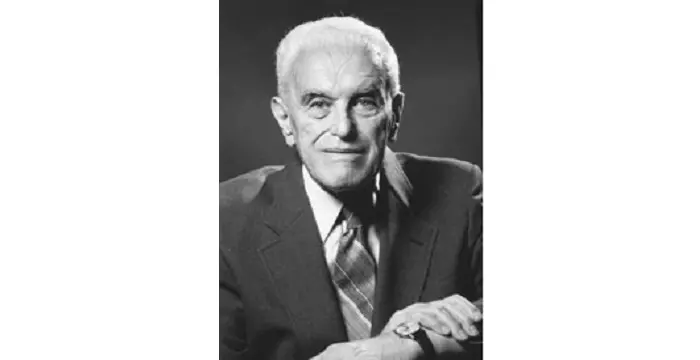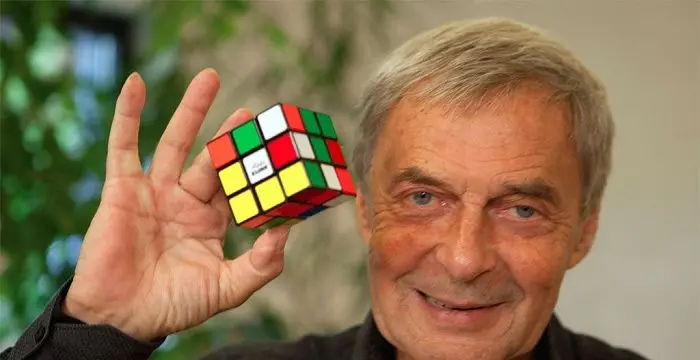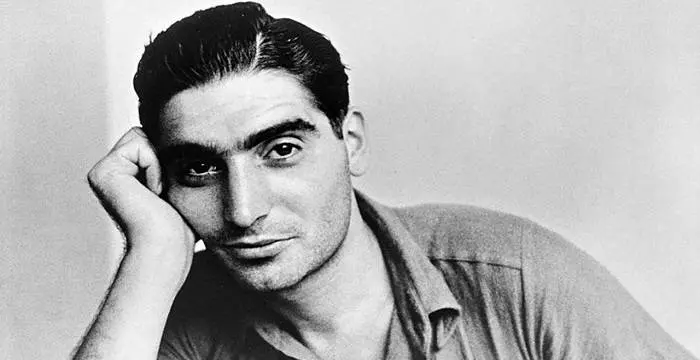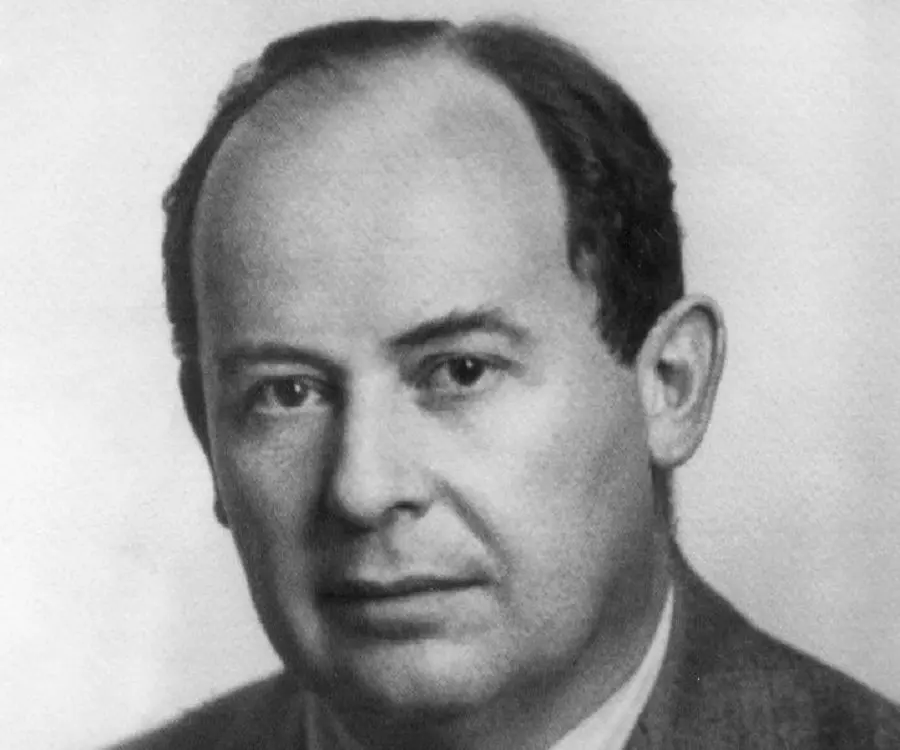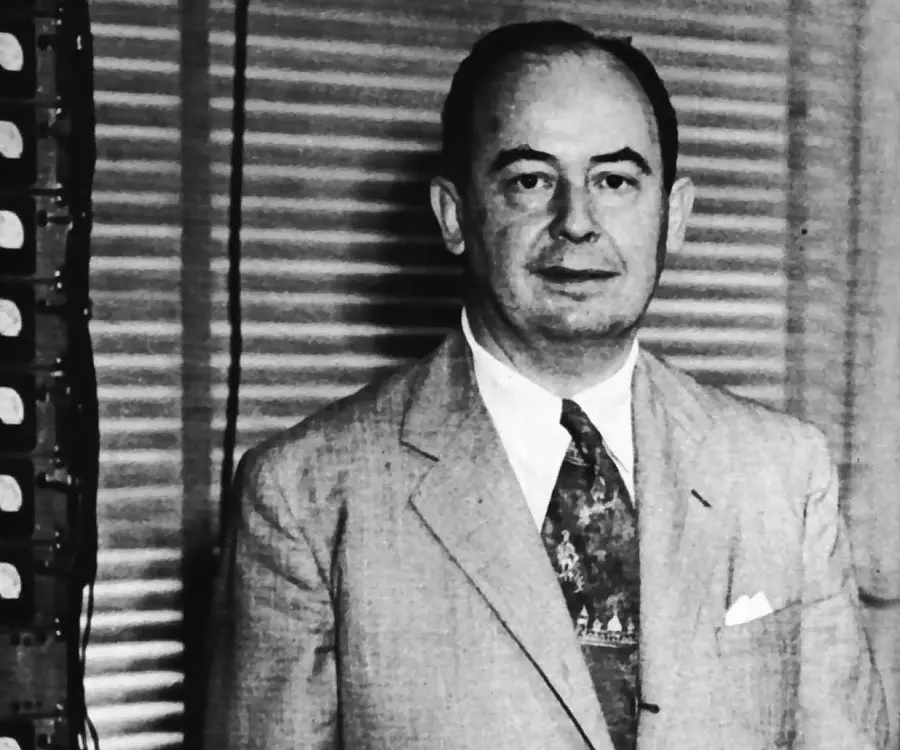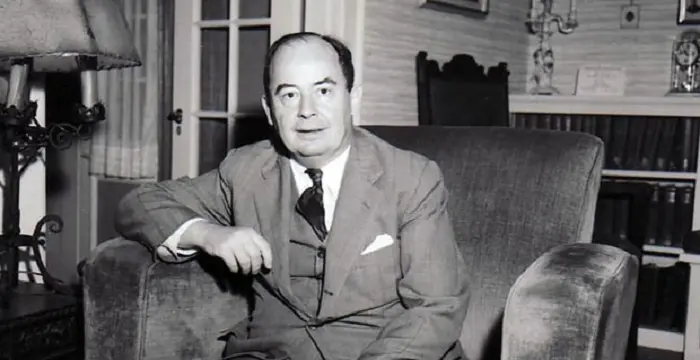
John von Neumann - Hungarian Men, Birthday and Personal Life
John von Neumann's Personal Details
John von Neumann was a Hungarian-American mathematician, physicist, inventor, computer scientist, and polymath
| Information | Detail |
|---|---|
| Birthday | December 28, 1903 |
| Died on | February 8, 1957 |
| Nationality | Hungarian, American |
| Famous | Scientists, Mathematicians, Hungarian Men |
| Spouses | Klara Dan |
| Childrens | Marina von Neumann Whitman |
| Universities |
|
| Birth Place | Budapest |
| Born Country | Hungary |
| Gender | Male |
| Father | Neumann Miksa |
| Mother | Kann Margit |
| Sun Sign | Capricorn |
| Born in | Budapest |
| Famous as | Mathematician |
| Died at Age | 53 |
// Famous Hungarian Men
John C Harsanyi
Read on to know the profile, career, important works, contributions and timeline of the famous American economist and Nobel Laureate, John C Harsanyi.
Erno Rubik
The famous inventor and educationist, Erno Rubik is known world-wide for his invention the ‘Rubik’s Cube’. To know more about the childhood, profile, timeline and career of this famous architect-inventor read on.
Robert Capa
Robert Capa was a Hungarian war photographer and photojournalist who later became a naturalized US citizen. This biography of Robert Capa provides detailed information about his childhood, life, achievements, works & timeline
John von Neumann's photo
Who is John von Neumann?
John von Neumann was a Hungarian-American mathematician, physicist, inventor, computer scientist, and polymath. Born in Budapest into a Jewish family, he shifted to the USA before the rise of Nazi power. There he started teaching mathematics in Princeton University, but was not successful as a professor mainly because his students found it hard to keep up with his speed. Later, as he joined a non-teaching position at the Institute of Advanced Study which closely collaborates with Princeton University, he began to flourish truly. Although he began his career as a pure mathematician, he later became more interested in applied mathematics, and as the Second World War broke out, he used his knowledge to contribute to war efforts. Throughout his life, he had published over 150 papers. Among them, sixty were in pure mathematics; another sixty in applied mathematics; twenty in physics and the rest were on miscellaneous subjects. He was a prolific writer and his last book, written from hospital bed, was published posthumously as ‘The Computer and the Brain’.
// Famous Scientists
Juliane Koepcke
Juliane Koepcke is a German-Peruvian biologist, who was the lone survivor among the 92 passengers and crew of the ill-fated LANSA Flight 508 that crashed in the Peruvian rainforest on 24 December 1971. Know more about her life in this biography.
Henry Cavendish
Henry Cavendish was a theoretical chemist and physicist, renowned for discovery of hydrogen and calculation of the mass of earth. To know more about his childhood, profile, timeline and career read on
Konstantin Tsiolkovsky
Konstantin Tsiolkovsky was a Russian rocket scientist and a pioneer of astronautics. This biography provides detailed information about his childhood, family, personal life, career, achievements, etc.
Childhood & Early Life
John von Neumann was born as Neumann János Lajos on December 28, 1903 into an affluent family in Budapest. His father, Miksa Neumann, was a banker. His mother, Kann Margit, came from a prosperous merchant family. He had two younger brothers, Michael and Nicholas.
Born a child prodigy, he could mentally divide and multiply multi-digit numbers from the age of six and became familiar with differential and integral calculus by the age of eight. Besides, he received lessons in Hungarian, English, French, German and Italian while studying at home under a governess.
In 1911, János was admitted to Fasori Evangélikus Gimnázium. Here his mathematical talent was quickly spotted by his teacher. Since his father insisted that he studied in grades appropriate to his age, additional especial tuitions were arranged for him to train him in fields in which he displayed an aptitude.
Neumann completed his education at the gymnasium in 1921. Although he wanted to study mathematics his father convinced him to study chemical engineering because it had better prospects. With that aim, he enrolled at the University of Berlin in 1921 for a two-year course in chemistry.
Simultaneously, he also enrolled at the University of Budapest with mathematics; but did not attend the classes there. Sometime now, he published two major mathematical papers.
The first paper, written jointly with Fekete, an assistant professor at the University of Budapest who had been tutoring him, was published in 1922. His second paper was published in 1923. In it, he provided the definition of ordinal number, which is still in use.
Also in 1923, after completing the two year course at Berlin, Neumann entered Eidgenössische Technische Hochschule Zürich to study chemical engineering. Sometime during this period, he also passed out from the University of Budapest with brilliant results.
Thereafter, along with studying chemical engineering at ETH Zurich he started his doctoral work in mathematics at Pázmány Péter University in Budapest. In 1926, he graduated from ETH Zurich. Soon after that, he also received his PhD degree from Pázmány Péter. His dissertation was on axiomatization of Cantor's set theory.
Neumann then joined University of Göttingen to study mathematics under David Hilbert on a grant from the Rockefeller Foundation. On December 13, 1927 he completed his habilitation. By then he had published twelve major papers in mathematics.
Early Career in Europe
In 1928, Neumann started his career as a privatdozent at the University of Berlin. In the same year, he published ‘ZurTheorie der Gesellschaftsspiele’ (On the Theory of Parlor Games), an important paper in the field of game theory.
All along, he kept on working with Hilbert. The work culminated into his first major book, ‘The Mathematical Foundations of Quantum Mechanics’; however, it was published much later in 1932.
In 1929, Neumann shifted to University of Hamburg as privatdozent because it offered better scope to become a tenured professor. However, he did not continue there for long.
In October 1929, he was invited to lecture on quantum theory at the Princeton University in New Jersey, USA. He accepted the offer; but since he was engaged to be married, he first went to Budapest to complete the ceremony and then moved to USA with his wife.
At Princeton University, USA
In 1930, Neumann became a visiting lecturer at Princeton University. Some time now, he started working on the theory of rings of operators with the aim of developing a mathematical technique suitable for quantum phenomenon. The work took almost a decade to finish and is now known as ‘von Neumann algebras’.
In 1931, he was appointed a full professor. He now began to write a series of articles in which he made foundational contributions to quasi ergodic theory.
However, as a professor of mathematics, he was not very popular with the students. This was because they could not keep up with him and found it hard to follow his fluid lines of thought. He wrote too quickly and rubbed it off before his students could copy it.
Contrarily, he was able to convey the complicated ideas in physics much more easily. After a talk, his students always returned with the feeling that the problem was actually very simple.
In 1933, the Institute of Advance Study was established at Princeton. Neumann became one of the six original Professors in Mathematics at the institute, a position he maintained throughout his life. In the same year, he also became co-editor of the ‘Annals of Mathematics.’
Until 1933, every summer he used to return to Germany, where he maintained his academic position. However, with the rise of the Nazis in Germany, he thought it prudent to resign and shifted permanently to Princeton.
In 1935, he became co-editor of ‘Compositio Mathematica.’ Concurrently, he also functioned as the co-editor of Annals of Mathematics and held both these positions until his death.
In 1937, he became a naturalized citizen of the United States of America. Around this time he also anglicized his name into John and added von Neumann as a mark of German nobility.
From 1937 to 1939, von Neumann concentrated on the Lattice Theory, in which he provided an abstract exploration of dimension in complemented modular topological lattices and later founded the field of continuous geometry based on it.
During Second World War
By late the 1930s, von Neumann had developed an expertise in explosions and became known as the leading authority of the mathematics of shaped charges. Later as the Second World War set in, he decided to join the United States Army, but was rejected because of his age.
Instead, because of his expertise in the mathematics of shaped charges, he was invited to work as a consultant in a number of military projects. Then in late 1943, he was invited to join the Manhattan Project.
At Manhattan, Neumann mainly worked on the explosive lenses, which are capable of compressing the plutonium core of the ‘Fat Man’, the nuclear bomb that was dropped on Nagasaki. He not only provided the concept, but also contributed to its design. Later as the committee was set up to choose the target cities, Neumann was inducted in it.
Moreover, he also oversaw calculations concerning the impact of the bomb blast, e.g. the estimated size of the blast, expected death tolls, the distance at which the bomb should be denoted for the maximum effect, etc.
Post War Period
In the post war period, Neumann began to work as a consultant both to the government and the industry. In fact, he started this work even before the end of the War. In 1944, for example, he worked with the U.S. Army contributing important ideas to the development of the hard-wired ENIAC computer.
Later, he worked as a consultant to the RAND Corporation, a think tank charged with planning nuclear strategy for the U.S. Air Force. In this capacity, he supported building of hydrogen bombs. Around 1950, he also advocated nuclear strike to destroy Soviet Union’s nuclear capability.
In 1954, Neumann was elected a member of the Atomic Energy Commission. He served in that capacity till 1956. During this period, he worked to develop the policy of nuclear deterrence for President Dwight D. Eisenhower’s administration.
Major Works
Von Neumann was the founder of many theories such as the Ergodic Theory, the Operator Theory, the Lattice Theory, Game Theory and the Measure Theory as well as a branch of geometry known as continuous geometry and the Von Neumann Algebras.
‘Theory of Games and Economic Behavior’, which Neumann had co-authored with economist Oskar Morgenstern, is however his most significant work. The book, published in 1944, created the interdisciplinary research field of game theory. The work was based on Neumann’s 1928 research work, ‘On the Theory of Parlor Games’.
Awards & Achievements
John von Neumann had received several awards; among them Bôcher Memorial Prize (1938), Navy Distinguished Civilian Service Award (1946), Medal for Merit (1946), Medal of Freedom (1956) and Enrico Fermi Award (1956) are the most significant.
Personal Life & Legacy
On January 1, 1930, von Neumann married Mariette Kövesi, who had studied economics at Budapest University. Soon after that, they shifted to the U.S.A, where their only child, Marina von Neumann Whitman, was born. The couple divorced in 1937.
Marina later grew up to be noted economist. She is now a Professor of Business Administration and Public Policy at the University of Michigan's Ross School of Business as well as The Gerald R. Ford School of Public Policy.
In October 1938, von Neumann married Klara Dan, a scientist, and a pioneering computer programmer. The couple did not have any children. They remained married until his death in 1957.
In 1955, von Neumann was diagnosed with cancer and his health deteriorated very quickly. In spite of that, he continued to work and in 1956, in an essay written for James Newman’s ‘The World of Mathematics’, he defended applied mathematics.
During his last days, fearing that he might reveal military secrets under medication, he was provided with military security. He died on February 8, 1957 at the Walter Reed Army Medical Center in Washington DC.
Apart from numerous mathematical formulas named after von Neumann, his legacy is being carried forward by a number of awards and lectures instituted in his honor.
A lunar impact crater that lies on the far side of the Moon, in the northern hemisphere, has also been named Von Neumann after him.
In 2005, he was depicted on 37-cent self adhesive US postage stamp, issued by United States Postal Service.
Trivia
Unlike most mathematicians, von Neumann worked better under chaotic conditions in living rooms and such places rather than in his study, which was rather secluded. He liked to socialize a lot and entertained regularly at home.
// Famous Mathematicians
Grigori Perelman
Grigori Perelman is a Russian mathematician who is best known for his contributions to Riemannian geometry and geometric topology. Check out this biography to know about his childhood, family life, achievements and fun facts about him.
Terence Tao
Terence Tao is an Australian- American mathematician who has contributed enormously to the field of mathematics. Check out this biography to know about his childhood, family life and achievements.
Isaac Newton
Isaac Newton was an English scientist and mathematician, who discovered gravitation and Newtonian Mechanics. Read this biography to find more on his life.
John von Neumann's awards
| Year | Name | Award |
|---|---|---|
Other | ||
| 0 | 1956 - Enrico Fermi Award | |
| 0 | 1938 - Bôcher Memorial Prize | |
John von Neumann biography timelines
- // 28th Dec 1903John von Neumann was born as Neumann János Lajos on December 28, 1903 into an affluent family in Budapest. His father, Miksa Neumann, was a banker. His mother, Kann Margit, came from a prosperous merchant family. He had two younger brothers, Michael and Nicholas.
- // 1911In 1911, János was admitted to Fasori Evangélikus Gimnázium. Here his mathematical talent was quickly spotted by his teacher. Since his father insisted that he studied in grades appropriate to his age, additional especial tuitions were arranged for him to train him in fields in which he displayed an aptitude.
- // 1921Neumann completed his education at the gymnasium in 1921. Although he wanted to study mathematics his father convinced him to study chemical engineering because it had better prospects. With that aim, he enrolled at the University of Berlin in 1921 for a two-year course in chemistry.
- // 1923The first paper, written jointly with Fekete, an assistant professor at the University of Budapest who had been tutoring him, was published in 1922. His second paper was published in 1923. In it, he provided the definition of ordinal number, which is still in use.
- // 1926Thereafter, along with studying chemical engineering at ETH Zurich he started his doctoral work in mathematics at Pázmány Péter University in Budapest. In 1926, he graduated from ETH Zurich. Soon after that, he also received his PhD degree from Pázmány Péter. His dissertation was on axiomatization of Cantor's set theory.
- // 13th Dec 1927Neumann then joined University of Göttingen to study mathematics under David Hilbert on a grant from the Rockefeller Foundation. On December 13, 1927 he completed his habilitation. By then he had published twelve major papers in mathematics.
- // 1928In 1928, Neumann started his career as a privatdozent at the University of Berlin. In the same year, he published ‘ZurTheorie der Gesellschaftsspiele’ (On the Theory of Parlor Games), an important paper in the field of game theory.
- // 1928 To 1944‘Theory of Games and Economic Behavior’, which Neumann had co-authored with economist Oskar Morgenstern, is however his most significant work. The book, published in 1944, created the interdisciplinary research field of game theory. The work was based on Neumann’s 1928 research work, ‘On the Theory of Parlor Games’.
- // 1929In 1929, Neumann shifted to University of Hamburg as privatdozent because it offered better scope to become a tenured professor. However, he did not continue there for long.
- // 1930In 1930, Neumann became a visiting lecturer at Princeton University. Some time now, he started working on the theory of rings of operators with the aim of developing a mathematical technique suitable for quantum phenomenon. The work took almost a decade to finish and is now known as ‘von Neumann algebras’.
- // 1st Jan 1930On January 1, 1930, von Neumann married Mariette Kövesi, who had studied economics at Budapest University. Soon after that, they shifted to the U.S.A, where their only child, Marina von Neumann Whitman, was born. The couple divorced in 1937.
- // 1931In 1931, he was appointed a full professor. He now began to write a series of articles in which he made foundational contributions to quasi ergodic theory.
- // 1932All along, he kept on working with Hilbert. The work culminated into his first major book, ‘The Mathematical Foundations of Quantum Mechanics’; however, it was published much later in 1932.
- // 1933In 1933, the Institute of Advance Study was established at Princeton. Neumann became one of the six original Professors in Mathematics at the institute, a position he maintained throughout his life. In the same year, he also became co-editor of the ‘Annals of Mathematics.’
- // 1935In 1935, he became co-editor of ‘Compositio Mathematica.’ Concurrently, he also functioned as the co-editor of Annals of Mathematics and held both these positions until his death.
- // 1937In 1937, he became a naturalized citizen of the United States of America. Around this time he also anglicized his name into John and added von Neumann as a mark of German nobility.
- // 1937 To 1939From 1937 to 1939, von Neumann concentrated on the Lattice Theory, in which he provided an abstract exploration of dimension in complemented modular topological lattices and later founded the field of continuous geometry based on it.
- // 1938 To 1956John von Neumann had received several awards; among them Bôcher Memorial Prize (1938), Navy Distinguished Civilian Service Award (1946), Medal for Merit (1946), Medal of Freedom (1956) and Enrico Fermi Award (1956) are the most significant.
- // 1938 To 1957In October 1938, von Neumann married Klara Dan, a scientist, and a pioneering computer programmer. The couple did not have any children. They remained married until his death in 1957.
- // 1944In the post war period, Neumann began to work as a consultant both to the government and the industry. In fact, he started this work even before the end of the War. In 1944, for example, he worked with the U.S. Army contributing important ideas to the development of the hard-wired ENIAC computer.
- // 1950Later, he worked as a consultant to the RAND Corporation, a think tank charged with planning nuclear strategy for the U.S. Air Force. In this capacity, he supported building of hydrogen bombs. Around 1950, he also advocated nuclear strike to destroy Soviet Union’s nuclear capability.
- // 1954In 1954, Neumann was elected a member of the Atomic Energy Commission. He served in that capacity till 1956. During this period, he worked to develop the policy of nuclear deterrence for President Dwight D. Eisenhower’s administration.
- // 1955In 1955, von Neumann was diagnosed with cancer and his health deteriorated very quickly. In spite of that, he continued to work and in 1956, in an essay written for James Newman’s ‘The World of Mathematics’, he defended applied mathematics.
- // 8th Feb 1957During his last days, fearing that he might reveal military secrets under medication, he was provided with military security. He died on February 8, 1957 at the Walter Reed Army Medical Center in Washington DC.
// Famous American peoples
Wentworth Miller
Wentworth Miller is an American actor and screenwriter who achieved recognition for his role in the TV series ‘Prison Break’.
Jason Simpson
Jason Simpson is the son of former NFL running back, broadcaster and actor O. J. Simpson. Check out this biography to know about his childhood, family, life, and little known facts about him.
Melissa Brim
Melissa Brim is the ex-girlfriend of former professional boxer Floyd Mayweather Jr. Check out this biography to know about her birthday, childhood, family life, achievements and fun facts about her.
Skai Jackson
Skai Jackson is an American child actress with huge fan following. Find more about her family & personal life, relationships, facts and more.
Joyce Meyer
Joyce Meyer is a Christian author and speaker. This biography provides detailed information about her childhood, life, achievements, works & timeline
Zoe LaVerne
Zoe LaVerne is an American musical.ly star. Check out this biography to know more about her family, personal life, including her age, birthday, etc.
John von Neumann's FAQ
What is John von Neumann birthday?
John von Neumann was born at 1903-12-28
When was John von Neumann died?
John von Neumann was died at 1957-02-08
Where was John von Neumann died?
John von Neumann was died in Washington, D.C.
Which age was John von Neumann died?
John von Neumann was died at age 53
Where is John von Neumann's birth place?
John von Neumann was born in Budapest
What is John von Neumann nationalities?
John von Neumann's nationalities is Hungarian, American
Who is John von Neumann spouses?
John von Neumann's spouses is Klara Dan
Who is John von Neumann childrens?
John von Neumann's childrens is Marina von Neumann Whitman
What was John von Neumann universities?
John von Neumann studied at University of Budapest, ETH Zurich
Who is John von Neumann's father?
John von Neumann's father is Neumann Miksa
Who is John von Neumann's mother?
John von Neumann's mother is Kann Margit
What is John von Neumann's sun sign?
John von Neumann is Capricorn
How famous is John von Neumann?
John von Neumann is famouse as Mathematician
